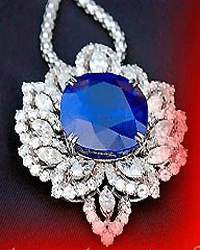A Royal Gem
Small numbers of diamonds appearing in European regalia and jewelry in the 13th century, set as accent points among pearls in splendid wrought gold. By the 16th century the diamonds become larger and more famous, in response to the development of diamond faceting, which enhances their brilliance and fire. Diamonds come to rule small jewels during the 17th century and large ones by the 18th century. They eventually supplant the gold settings in visual impact, so gold is replaced with the more sympathetically colored metal, silver, and, later, platinum.
An act of Saint Louis (Louis IX of France, 1214-70) that recognized a sumptuary law reserving diamonds for the king bespeaks the rarity of diamonds and the value conferred on them at that time. Within 100 years diamonds appeared in royal jewelry of both men and women, then among the superior European aristocracy, with the wealthy merchant class showing the occasional diamond by the 17th century.

The earliest European ornamental and regal applications feature diamond points that look like the Roman style of natural points in rings. Unlike the Roman cases, the European points may have been polished, if only to remove surface irregularities and coatings of any foreign mineral. The taboo on modifying a diamond crystal into a gem, which originated in India, ends about this time in both Europe and India. There is no recorded explanation, but the implications of the rise of diamond's fame in ornamentation are nothing short of revolutionary -- as more diamonds reach Europe, demand for the brilliant gem increases.
The initial diamond-cutting industry is believed to have been in Venice, a trade capital, starting sometime after 1330. Diamond cutting might have arrived in Paris by the late 14th century; for Bruges -- on the diamond trade route -- there is documentation for the technique in 1465.
<< Back | Next >>